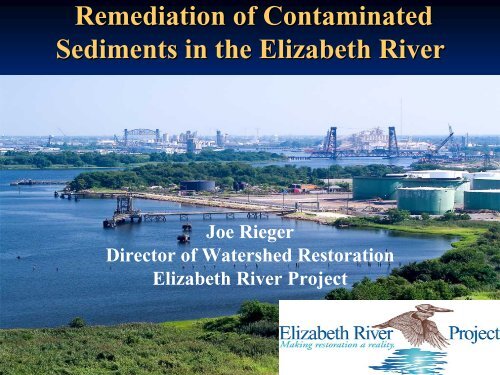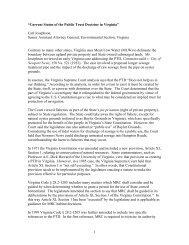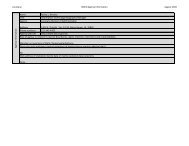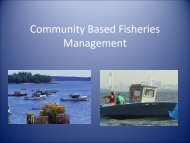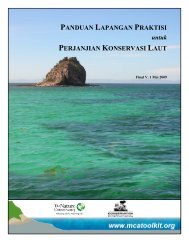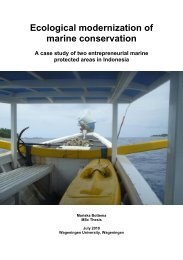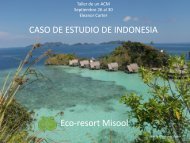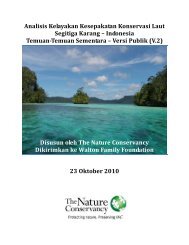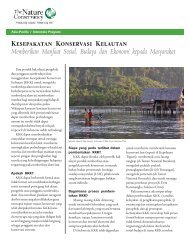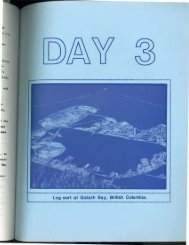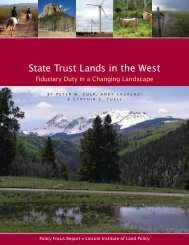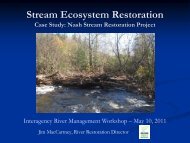Remediation of Contaminated Sediments in the Elizabeth River
Remediation of Contaminated Sediments in the Elizabeth River
Remediation of Contaminated Sediments in the Elizabeth River
You also want an ePaper? Increase the reach of your titles
YUMPU automatically turns print PDFs into web optimized ePapers that Google loves.
<strong>Remediation</strong> <strong>of</strong> <strong>Contam<strong>in</strong>ated</strong><br />
<strong>Sediments</strong> <strong>in</strong> <strong>the</strong> <strong>Elizabeth</strong> <strong>River</strong><br />
Joe Rieger<br />
Director <strong>of</strong> Watershed Restoration<br />
<strong>Elizabeth</strong> <strong>River</strong> Project
Presentation Outl<strong>in</strong>e<br />
• Who is <strong>the</strong> <strong>Elizabeth</strong> <strong>River</strong> Project<br />
• Strategy for restor<strong>in</strong>g <strong>the</strong> <strong>Elizabeth</strong> <strong>River</strong><br />
• Who is <strong>the</strong> Liv<strong>in</strong>g <strong>River</strong> Trust<br />
• Sediment <strong>Remediation</strong> Case Study: Money Po<strong>in</strong>t<br />
• Sediment <strong>Remediation</strong> Case Study: Atlantic Wood<br />
• Lessons learned: Factors needed for effective urban<br />
restoration
<strong>Elizabeth</strong> <strong>River</strong><br />
Watershed<br />
‣ 200 sq. mile watershed<br />
‣ 4 cities<br />
Ma<strong>in</strong>stem<br />
Portsmouth<br />
Lafayette <strong>River</strong><br />
‣ Great Dismal Swamp<br />
freshwater source<br />
‣ Trap Estuary<br />
ERP Office<br />
Virg<strong>in</strong>ia Beach<br />
Chesapeake
The <strong>Elizabeth</strong> <strong>River</strong> Project<br />
- 15 years <strong>of</strong> river restoration -<br />
Mission: Restore <strong>the</strong> <strong>Elizabeth</strong> <strong>River</strong> to <strong>the</strong> highest<br />
practical level <strong>of</strong> environmental quality with<br />
government, bus<strong>in</strong>ess, & community partnerships.
‣ Establish partnerships between<br />
government, bus<strong>in</strong>esses and<br />
citizens to achieve real<br />
environmental results<br />
‣ Today: 2,000 members, 59<br />
<strong>in</strong>dustries, four cities, state and<br />
federal government, many<br />
o<strong>the</strong>rs, achiev<strong>in</strong>g<br />
environmental results toge<strong>the</strong>r.
The Plan for restor<strong>in</strong>g <strong>the</strong> <strong>Elizabeth</strong><br />
<strong>River</strong>
Our Compass –<br />
Watershed Action Plan<br />
‣ One <strong>of</strong> <strong>the</strong> 1 st Sub-Watershed<br />
Plans completed on <strong>the</strong> Bay<br />
(1996)<br />
‣ Focused efforts on priority<br />
actions that will make <strong>the</strong> most<br />
difference<br />
‣ Developed with 120<br />
stakeholders from government,<br />
science, citizen groups and<br />
<strong>in</strong>dustry
2020 Goals:<br />
• Action 1- 1 Br<strong>in</strong>g mummichog<br />
cancer with<strong>in</strong> naturally<br />
occurr<strong>in</strong>g background levels.<br />
• Action 2-Restore 2<br />
& conserve<br />
10 miles <strong>of</strong> river corridors<br />
with projects <strong>in</strong> all four cities.<br />
• Action 3- 3 Create 10 miles <strong>of</strong><br />
shorel<strong>in</strong>e with <strong>in</strong>dustrial<br />
facilities adopt<strong>in</strong>g voluntary<br />
P2 as a <strong>River</strong> Star.<br />
14 Actions <strong>in</strong> plan
<strong>Elizabeth</strong> <strong>River</strong> sediment<br />
contam<strong>in</strong>ation, <strong>the</strong> highest PAH levels <strong>in</strong><br />
<strong>the</strong> Chesapeake Bay<br />
(Some sites are over 1,000 times average for bay)
Watershed<br />
Action Plan<br />
Action 1, Goo must go!<br />
Clean up toxic river<br />
bottom.<br />
Mummichog populations<br />
have over 70% precancerous<br />
lesions<br />
- Underway: Money Po<strong>in</strong>t,<br />
Atlantic Wood, Scuffletown<br />
Atlantic Wood<br />
Money Po<strong>in</strong>t<br />
Scuffletown<br />
Creek<br />
Sediment<br />
<strong>Remediation</strong> Sites
Sediment<br />
<strong>Remediation</strong><br />
Projects on<br />
<strong>the</strong> <strong>Elizabeth</strong><br />
<strong>River</strong><br />
Atlantic Wood Industries<br />
Money Po<strong>in</strong>t<br />
Sediment <strong>Remediation</strong> Sites
Impact at New Port Facility<br />
• 189 acres <strong>of</strong> subaqueous dredged<br />
• 10.3 million cubic yards dredged<br />
• Periodical ma<strong>in</strong>tenance dredg<strong>in</strong>g
Liv<strong>in</strong>g <strong>River</strong> Restoration Trust:<br />
First mitigation In-lieu fee fund <strong>in</strong> US for sediment cleanup
Money Po<strong>in</strong>t Restoration and<br />
Revitalization<br />
Money<br />
Po<strong>in</strong>t
$5.3 million from<br />
<strong>Elizabeth</strong> <strong>River</strong><br />
Restoration Trust: <strong>in</strong>lieu<br />
fee, is clean<strong>in</strong>g up<br />
worst sediment site on<br />
river… one <strong>of</strong> worst <strong>in</strong><br />
world
Money Po<strong>in</strong>t Revitalization Task Force<br />
‣Stakeholders worked toge<strong>the</strong>r for 2 years and came up<br />
with an agreed upon cleanup plan.<br />
‣University <strong>of</strong> VA Institute for Environmental<br />
Negotiation facilitated development <strong>of</strong> a corridor<br />
restoration plan (Andrus Foundation grant, $100,000)<br />
Industrial landowners<br />
Nearby residents<br />
City <strong>of</strong> Chesapeake<br />
State/federal <strong>in</strong>terests<br />
Expert advisors
Landscape Approach<br />
Seven <strong>in</strong>dustrial partners, UVA, City,<br />
state, federal partners participat<strong>in</strong>g <strong>in</strong><br />
revitalization plan.
Money Po<strong>in</strong>t Sediment <strong>Remediation</strong><br />
Summary<br />
• 19-acre remediation area<br />
• 8,000 ppm TPAH maximum<br />
• 500 ppm TPAH average<br />
• 120,000 CY above 45 ppm TPAH<br />
• 85,000 CY conceptual dredge prism<br />
• Dredge material end-use not determ<strong>in</strong>ed
Sou<strong>the</strong>rn Area Habitat Enhancement<br />
Alternative 5A:<br />
Dredg<strong>in</strong>g with Sand Cover<br />
Remedial Action<br />
Dredge to 1' : 9,574 sy<br />
Dredge to 3' : 6,290 sy<br />
Dredge to 4' : 39,700 sy<br />
Dredge to 5' : 13,320 sy<br />
Sand Cover : 32,250 sy<br />
Alternative 5B:<br />
Dredg<strong>in</strong>g with Habitat Cover<br />
Remedial Action<br />
Dredge to 1' : 2,320 sy<br />
Dredge to 3' : 6,290 sy<br />
Dredge to 4' : 39,700 sy<br />
Dredge to 5' : 13,320 sy<br />
Salt Marsh (0 -2') : 10,720 sy<br />
Oyster Reef (2-8') : 10,300 sy<br />
S<strong>of</strong>t Bottom Habitat (> 8') : 11,230 sy<br />
Area (sy) Volume (cy)<br />
Dredge to 1' 9,570 3,190<br />
Dredge to 3' 59,310 59,310<br />
Dredge from 3-4' 53,020 17,673<br />
Dredge from 4-5' 13,320 4,440<br />
Total: 84,613<br />
Area (sy) Volume (cy)<br />
Dredge to 1' 2,320 773<br />
Whole Area to 3' 59,310 59,310<br />
Dredge from 3-4' 53,020 17,673<br />
Dredge from 4-5' 13,320 4,440<br />
Total: 82,197<br />
Granite Berm<br />
Navigation Channel<br />
Surface PAH (mg/Kg)<br />
< 45<br />
45 - 100<br />
100 - 500<br />
500 - 1,000<br />
1,000 - 2,000<br />
2,000 - 3,000<br />
> 3,000<br />
Hotspot > 500 mg/Kg<br />
Granite Berm<br />
Navigation Channel<br />
Surface PAH (mg/Kg)<br />
< 45<br />
45 - 100<br />
100 - 500<br />
500 - 1,000<br />
1,000 - 2,000<br />
2,000 - 3,000<br />
> 3,000<br />
Hotspot > 500 mg/Kg
• Sand Layer<br />
placement:<br />
10,000 CY<br />
• Saltwater<br />
Marsh<br />
construction:<br />
2-acres<br />
• Oyster Reef<br />
construction:<br />
4.3-acres
Project Status<br />
• Focused Feasibility Study completed<br />
• Initial Design / Build RFP solicited May 2007<br />
• Bidders identified many project uncerta<strong>in</strong>ties<br />
result<strong>in</strong>g <strong>in</strong> high bids<br />
• New RFP scope will identify a dredge material<br />
end-use option, develop a project design, obta<strong>in</strong><br />
project permits, and prepare construction bid<br />
specs.
Atlantic Wood Sediment<br />
<strong>Remediation</strong><br />
Atlantic<br />
Wood
Wetland & Oyster<br />
Restoration
Sub Aqueous<br />
Fill
Project Issues to be Addressed<br />
• Permanent lost <strong>of</strong> river bottom<br />
• Permanent lost <strong>of</strong> wetlands and sand beach<br />
habitat<br />
• Upland owners could become land locked<br />
• Possible structural issues with cut<strong>of</strong>f wall
Lessons Learned From <strong>the</strong> Money<br />
1) Community consensus on<br />
a sediment remediation,<br />
however long and difficult<br />
this process may seem, can<br />
be a powerful foundation.<br />
Po<strong>in</strong>t Project<br />
2) If you want your project<br />
implemented, you must sit<br />
at <strong>the</strong> table with everyone,<br />
especially anyone who<br />
could stop you – and listen.
Lessons learned – Local Involvement<br />
3) Don’t be afraid<br />
to collaborate<br />
with players<br />
who have a long<br />
way to go. They<br />
have <strong>the</strong> greatest<br />
potential to<br />
improve <strong>the</strong><br />
watershed.
Questions


